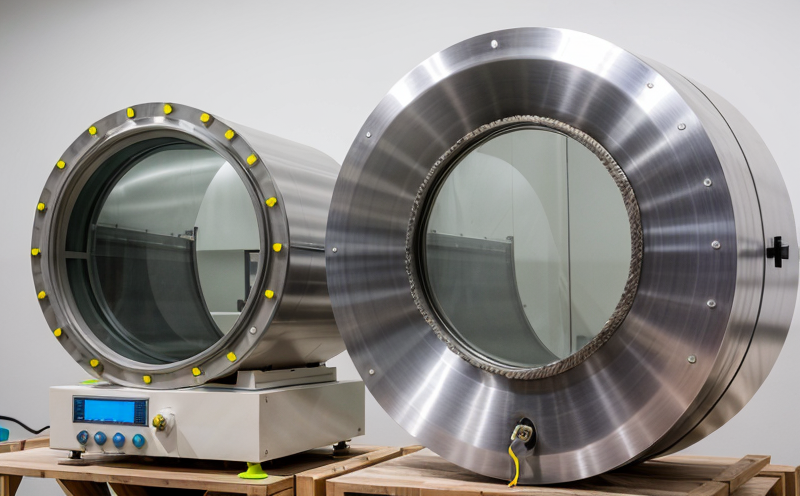ASTM C1833 Thermal Neutron Absorption Testing of Shielding Materials
The ASTM C1833 thermal neutron absorption testing is a critical procedure used in the evaluation of materials intended for use as radiation shielding. This test method provides data on how effectively various shield materials absorb thermal neutrons, which are essential for understanding their performance in nuclear applications such as reactor design and radiation protection.
The primary purpose of ASTM C1833 testing is to determine the neutron absorption cross-sections of materials used in radiation shielding. These cross-sections indicate the probability that a neutron will be absorbed by an atom, which is crucial for designing effective shielding against thermal neutrons. This test is particularly important for ensuring safety and compliance with nuclear standards.
The ASTM C1833 process involves exposing samples to a neutron flux of known intensity and spectrum. The absorption of these neutrons by the sample material is measured using appropriate instrumentation, such as an ionization chamber or a calorimeter. This allows the calculation of the effective cross-sections for thermal neutron capture.
Understanding the results from ASTM C1833 testing is vital for industries involved in nuclear energy production and radiation protection. For example, power plant operators need to ensure that their shielding materials are adequate to prevent unwanted exposure to personnel and the environment. Similarly, manufacturers of radiation detectors or medical devices relying on neutron capture must verify the performance of their products.
The ASTM C1833 methodology is widely recognized for its accuracy and reliability, making it a standard choice in the industry. It ensures that materials meet the specified requirements for neutron absorption efficiency, which is critical for nuclear safety.
Specimens prepared for this test typically consist of small, uniform samples cut from larger blocks of the material to be tested. The specimens must be free from cracks or other defects that could affect their performance during testing. Prior to testing, these specimens undergo rigorous quality assurance checks to ensure they meet the necessary specifications.
The instrumentation used in ASTM C1833 testing includes a neutron source and detection equipment capable of measuring the absorbed neutrons accurately. The process involves exposing the sample to a controlled neutron flux, allowing sufficient time for neutron absorption to occur. After exposure, the absorbed neutrons are detected using sensitive detectors that provide precise measurements.
The results of ASTM C1833 testing are reported in terms of the effective neutron cross-sections of the materials tested. These values indicate how efficiently different materials can absorb thermal neutrons and form the basis for selecting appropriate shielding materials in various applications.
Applied Standards
| Standard Number | Description |
|---|---|
| ASTM C1833-XX | Standard Test Method for Thermal Neutron Absorption Cross-Sections of Shielding Materials |
The ASTM C1833 test method is based on international standards that ensure consistent and reliable results across different laboratories. This standard provides detailed procedures for preparing specimens, conducting the tests, and interpreting the data obtained. Compliance with these standards ensures that the testing process is standardized and can be replicated by any accredited laboratory.
The use of internationally recognized standards like ASTM C1833 promotes consistency in testing practices worldwide. By adhering to these guidelines, laboratories can produce results that are universally accepted and comparable across different regions and industries. This standardization is crucial for maintaining the integrity of nuclear safety regulations and ensuring public trust in radiation shielding materials.
It's important to note that ASTM C1833 is one of several standards used in neutron absorption testing, each targeting specific aspects of material performance under various conditions. For instance, other relevant standards include ASTM E569 for determining elastic properties by wave propagation and ISO 24077 for gamma-ray attenuation tests.
The application of these standards ensures that the testing process is not only precise but also aligns with global best practices in nuclear safety and radiation protection. By following these guidelines, laboratories can provide accurate data that are essential for making informed decisions regarding material selection and design optimization.
Scope and Methodology
The ASTM C1833 test method is designed to evaluate the thermal neutron absorption properties of materials intended for use in radiation shielding. The scope of this standard covers the preparation of specimens, the exposure conditions used during testing, and the analysis of results.
- Specimen Preparation: Specimens must be cut from larger blocks of the material to ensure uniformity and free from defects that could affect test results.
- Exposure Conditions: The specimens are exposed to a controlled neutron flux, allowing sufficient time for thermal neutrons to be absorbed by the material.
- Data Analysis: Absorbed neutrons are detected using sensitive detectors capable of providing precise measurements. These readings are then used to calculate the effective neutron cross-sections of the materials tested.
The ASTM C1833 methodology is comprehensive, ensuring that all aspects of thermal neutron absorption testing are addressed accurately and consistently. This approach guarantees reliable data for decision-making purposes in nuclear safety applications.
Compliance with these specifications ensures accurate results, which are essential for meeting regulatory requirements and ensuring the safety of personnel and the environment. By adhering to ASTM C1833, laboratories can provide clients with confidence that their testing meets the highest industry standards.
Why Choose This Test
- Accurate Data: ASTM C1833 provides precise measurements of thermal neutron absorption cross-sections, ensuring reliable data for decision-making.
- Comprehensive Scope: The test method covers the entire process from specimen preparation to final analysis, providing a comprehensive evaluation of material performance.
The ASTM C1833 thermal neutron absorption testing is an essential tool in the nuclear industry. It helps ensure that materials used for radiation shielding meet strict safety standards and are effective in their intended applications. By choosing this test, organizations can gain valuable insights into the performance of their materials, ensuring compliance with regulatory requirements and enhancing overall safety.
ASTM C1833 testing is particularly beneficial for industries involved in nuclear energy production, medical device manufacturing, and radiation protection. It enables these sectors to make informed decisions about material selection and design optimization based on accurate test results.





